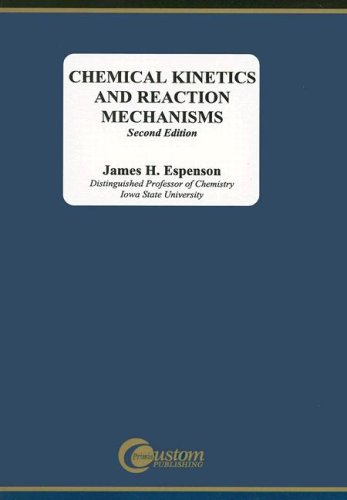Chemical kinetics and reaction mechanisms book download
Par may bill le jeudi, juin 2 2016, 01:11 - Lien permanent
Chemical kinetics and reaction mechanisms. James H. Espenson

Chemical.kinetics.and.reaction.mechanisms.pdf
ISBN: 0070202605,9780070202603 | 296 pages | 8 Mb

Chemical kinetics and reaction mechanisms James H. Espenson
Publisher: McGraw-Hill Science/Engineering/Math
16.2.1, Explain that reactions can occur by more than one step and that the slowest step determines the rate of reaction (rate-determining step). Atomic structure, chemical thermodynamics, theory of gases, electrochemistry, chemical kinetics, etc are the main topics included under physical chemistry. That means that whatever mechanism we propose for this reaction has to explain this data. Chemical Kinetics Example in Chemistry is being discussed at Physics Forums. It begins by introducing chemical kinetics and the analysis of reaction mechanism, from basic. Additionally, the base H/N/O mechanism was expanded to include carbon chemistry and was tested against flames of dimethylamine, ethylamine, and a methane/ammonia mixture. Whereas on the other hand the rate laws are consequence of the reaction mechanism and can be various even for the same reaction. In this review, I will show a few significant research outcomes about kinetic mechanism and modeling of the thermal-chemical conversion of lignin over the fast five years. Introduction to reaction kinetics. In this General Chemistry lecture, we continue the conversation about kinetics by considering how to predict the rate law for an overall reaction mechanism from a series of elementary steps. Steady-state and equilibrium approximations. Our understanding of chemical kinetics — the idea of the transition state, for example — was established based on the reactions of atoms with diatomic molecules, in particular,. Mechanism and detailed kinetic modeling of Scheme of main reaction participants and pathways of the depolymerization of wheat straw lignin; gaseous products of ethanol and formic acid gasification take part in reactions 2−4, 7−9, 14, and 17 [3]. Complex reactions and mechanisms. Applications: chemical and phase equilibria. Download Chemical kinetics and reaction mechanisms. For most students some of the most difficult problems in organic chemistry are those that deal with reaction mechanisms, which fall under the general heading of Chemical Kinetics. The concept of translation as a mechanism for polymer synthesis that is introduced in this current study should be embraced by others and molecules react to form new molecules, and understanding how these reactions occur, allows us to model chemical change, from interstellar dust clouds to living systems. Chemical kinetics and reaction mechanisms book download. By the way, see how useful chemical kinetics can be?